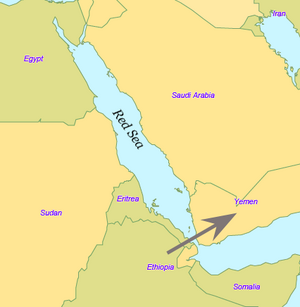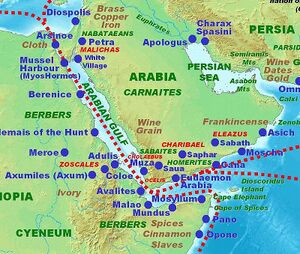Somalia


Somalia (सोमालिया) is a country located in the Horn of Africa.
Location
It is bordered by Ethiopia to the west, the Gulf of Aden to the north, the Guardafui Channel and Somali Sea to the east, and Kenya to the southwest. Somalia has the longest coastline on Africa's mainland, and its terrain consists mainly of plateaus, plains, and highlands.[1]
History
Prehistory: Somalia has been inhabited since at least the Paleolithic. During the Stone Age, the Doian and Hargeisan cultures flourished here.[2]
The oldest evidence of burial customs in the Horn of Africa comes from cemeteries in Somalia dating back to the 4th millennium BCE.[3]
The stone implements from the Jalelo site in the north were also characterized in 1909 as important artefacts demonstrating the archaeological universality during the Paleolithic between the East and the West.[4]
According to linguists, the first Afroasiatic-speaking populations arrived in the region during the ensuing Neolithic period from the family's proposed urheimat ("original homeland") in the Nile Valley,[5] or the Near East.[6]
The Laas Geel complex on the outskirts of Hargeisa in northwestern Somalia dates back approximately 5,000 years, and has rock art depicting both wild animals and decorated cows.[7] Other cave paintings are found in the northern Dhambalin region, which feature one of the earliest known depictions of a hunter on horseback. The rock art is in the distinctive Ethiopian-Arabian style, dated to 1,000 to 3,000 BCE.[8][9] Additionally, between the towns of Las Khorey and El Ayo in northern Somalia lies Karinhegane, the site of numerous cave paintings of real and mythical animals. Each painting has an inscription below it, which collectively have been estimated to be around 2,500 years old.[10][11]
Antiquity and classical era
Ancient pyramidical structures, mausoleums, ruined cities and stone walls, such as the Wargaade Wall, are evidence of an old civilization that once thrived in the Somali peninsula.[12][13] This civilization enjoyed a trading relationship with ancient Egypt and Mycenaean Greece since the second millennium BCE, supporting the hypothesis that Somalia or adjacent regions were the location of the ancient Land of Punt.[14][15] The Puntites traded myrrh, spices, gold, ebony, short-horned cattle, ivory and frankincense with the Egyptians, Phoenicians, Babylonians, Indians, Chinese and Romans through their commercial ports.
An Egyptian expedition sent to Punt by the 18th dynasty Queen Hatshepsut is recorded on the temple reliefs at Deir el-Bahari, during the reign of the Puntite King Parahu and Queen Ati.[16]
In 2015, isotopic analysis of ancient baboon mummies from Punt that had been brought to Egypt as gifts indicated that the specimens likely originated from an area encompassing eastern Somalia and the Eritrea-Ethiopia corridor.[17]
In the classical era, the Macrobians, who may have been ancestral to Somalis, established a powerful tribal kingdom that ruled large parts of modern Somalia. They were reputed for their longevity and wealth, and were said to be the "tallest and handsomest of all men".[18] The Macrobians were warrior herders and seafarers. According to Herodotus' account, the Persian Emperor Cambyses II, upon his conquest of Egypt in 525 BC, sent ambassadors to Macrobia, bringing luxury gifts for the Macrobian king to entice his submission. The Macrobian ruler, who was elected based on his stature and beauty, replied instead with a challenge for his Persian counterpart in the form of an unstrung bow: if the Persians could manage to draw it, they would have the right to invade his country; but until then, they should thank the gods that the Macrobians never decided to invade their empire.[19][20] The Macrobians were a regional power reputed for their advanced architecture and gold wealth, which was so plentiful that they shackled their prisoners in golden chains.[21]
The camel is believed to have been domesticated in the Horn region sometime between the 2nd and 3rd millennium BCE. From there, it spread to Egypt and the Maghreb.[22]
During the classical period, the Barbara city-states also known as sesea of Mosylon, Opone, Mundus, Isis, Malao, Avalites, Essina,Nikon and Sarapion developed a lucrative trade network, connecting with merchants from Ptolemaic Egypt, Ancient Greece, Phoenicia, Parthian Persia, Saba, the Nabataean Kingdom, and the Roman Empire. They used the ancient Somali maritime vessel known as the beden to transport their cargo.
After the Roman conquest of the Nabataean Empire and the Roman naval presence at Aden to curb piracy, Arab and Somali merchants agreed with the Romans to bar Indian ships from trading in the free port cities of the Arabian peninsula[23] to protect the interests of Somali and Arab merchants in the lucrative commerce between the Red Sea and Mediterranean Seas.[24] However, Indian merchants continued to trade in the port cities of the Somali peninsula, which was free from Roman interference.[25]
For centuries, Indian merchants brought large quantities of cinnamon to Somalia and Arabia from Ceylon and the Spice Islands. The source of the cinnamon and other spices is said to have been the best-kept secret of Arab and Somali merchants in their trade with the Roman and Greek world; the Romans and Greeks believed the source to have been the Somali peninsula.[26] The collusive agreement among Somali and Arab traders inflated the price of Indian and Chinese cinnamon in North Africa, the Near East, and Europe, and made the cinnamon trade a very profitable revenue generator, especially for the Somali merchants through whose hands large quantities were shipped across sea and land routes.[27]
In antiquity, Somalia was an important commercial centre.[28][29] It is among the most probable locations of the fabled ancient Land of Punt.[30][31][32]
During the Middle Ages
During the Middle Ages, several powerful Somali empires dominated the regional trade, including the Ajuran Empire, the Adal Sultanate, the Warsangali Sultanate, and the Sultanate of the Geledi. The toponym Somalia was coined by the Italian explorer Luigi Robecchi Bricchetti (1855–1926).[33]
Jat History

Gangaram Chaudhari Soi: Subedar Gangaram Chaudhari (Soi) (b.14.8.1956-d.22.8.1994) was from village Dhandhaniya in Shergarh tahsil in Jodhpur district of Rajasthan. He was awarded Shaurya Chakra for his bravery in Somalia Mission. The Shaurya Chakra award was received by her widow wife Smt Gogi Devi from President of India on 26 January 1995.
See also
References
- ↑ The World Factbook. Langley, Virginia: Central Intelligence Agency. 2018.
- ↑ Peter Robertshaw (1990). A History of African Archaeology. J. Currey. p. 105. ISBN 978-0-435-08041-9.
- ↑ Brandt, S. A. (1988). "Early Holocene Mortuary Practices and Hunter-Gatherer Adaptations in Southern Somalia". World Archaeology. 20 (1): 40–56. doi:10.1080/00438243.1988.9980055. JSTOR 124524. PMID 16470993.
- ↑ H. W. Seton-Karr (1909). "Prehistoric Implements From Somaliland". 9 (106). Man: 182–183.
- ↑ Zarins, Juris (1990), "Early Pastoral Nomadism and the Settlement of Lower Mesopotamia", (Bulletin of the American Schools of Oriental Research)
- ↑ Diamond J, Bellwood P (2003) "Farmers and Their Languages: The First Expansions" Science 300, doi:10.1126/science.1078208
- ↑ Bakano, Otto (24 April 2011). "Grotto galleries show early Somali life". Agence France-Presse. Archived from the original on 21 September 2013
- ↑ Mire, Sada (2008). "The Discovery of Dhambalin Rock Art Site, Somaliland". African Archaeological Review. 25 (3–4): 153–168. doi:10.1007/s10437-008-9032-2. Archived from the original on 27 June 2013.
- ↑ Alberge, Dalya (17 September 2010). "UK archaeologist finds cave paintings at 100 new African sites". The Guardian.
- ↑ Hodd, Michael (1994). East African Handbook. Trade & Travel Publications. p. 640. ISBN 0-8442-8983-3.
- ↑ Ali, Ismail Mohamed (1970). Somalia Today: General Information. Ministry of Information and National Guidance, Somali Democratic Republic. p. 295.
- ↑ Njoku, Raphael Chijioke (2013). The History of Somalia. ABC-CLIO. pp. 29–31. ISBN 978-0-313-37857-7.
- ↑ Dalal, Roshen (2011). The Illustrated Timeline of the History of the World. The Rosen Publishing Group. p. 131. ISBN 978-1-4488-4797-6.
- ↑ Njoku, Raphael Chijioke (2013). The History of Somalia. ABC-CLIO. pp. 29–31. ISBN 978-0-313-37857-7.
- ↑ Njoku, Raphael Chijioke (2013). The History of Somalia. ABC-CLIO. pp. 29–31. ISBN 978-0-313-37857-7.
- ↑ Njoku, Raphael Chijioke (2013). The History of Somalia. ABC-CLIO. pp. 29–31. ISBN 978-0-313-37857-7.
- ↑ NATHANIEL J. DOMINY1, SALIMA IKRAM, GILLIAN L. MORITZ, JOHN N. CHRISTENSEN, PATRICK V. WHEATLEY, JONATHAN W. CHIPMAN. "Mummified baboons clarify ancient Red Sea trade routes". American Association of Physical Anthropologists.
- ↑ The Geography of Herodotus: Illustrated from Modern Researches and Discoveries by James Talboys Wheeler, pg 1xvi, 315, 526
- ↑ The Geography of Herodotus: Illustrated from Modern Researches and Discoveries by James Talboys Wheeler, pg 1xvi, 315, 526
- ↑ John Kitto, James Taylor, The popular cyclopædia of Biblical literature: condensed from the larger work, (Gould and Lincoln: 1856), p.302.
- ↑ John Kitto, James Taylor, The popular cyclopædia of Biblical literature: condensed from the larger work, (Gould and Lincoln: 1856), p.302.
- ↑ Suzanne Richard (2003) Near Eastern archaeology: a reader, EISENBRAUNS, p. 120 ISBN 1-57506-083-3.
- ↑ Warmington, Eric Herbert (1995). The Commerce Between the Roman Empire and India. South Asia Books. ISBN 81-215-0670-0.p.54
- ↑ Warmington 1995, p. 229
- ↑ Warmington 1995, p. 187.
- ↑ Warmington 1995, pp. 185–6.
- ↑ Warmington 1995, p. 229.
- ↑ John Kenrick 1855) Phoenicia, B. Fellowes, p. 199.
- ↑ Casson, Lionel (1984). Ancient Trade and Society. Mich. p. 235. ISBN 0-8143-1740-5.
- ↑ Charnan Simon (1990). Explorers of the Ancient World. Childrens Press. p. 26. ISBN 0-516-03053-1.
- ↑ Christine El Mahdy (2005) Egypt : 3000 Years of Civilization Brought to Life, Raincoast Books, p. 297, ISBN 1-55192-879-5.
- ↑ Stefan Goodwin (2006) Africa's Legacies of Urbanization: Unfolding Saga of a Continent, Lexington Books, p. 48, ISBN 0-7391-0731-3.
- ↑ Exibit "Un esploratore pavese in Africa – Le collezioni zoologiche di Luigi Bricchetti Robecchi al Museo di Storia Naturale di Pavia" (2014)

